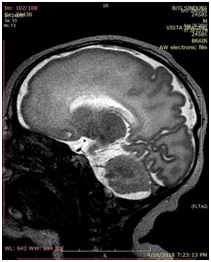Lissencephaly– a rare cause of neonatal seizures
Abstract
The most prominent feature of neurologic dysfunction in the neonatal period is seizures. The incidence of neonatal seizures is 0.5-3 per 1000 live births in term infants and 11-13% in premature babies. Although common causes of neonatal seizures comprises HIE, IVH, Sepsis, Hypoglycaemia, Hypocalcaemia etc. Sometimes rare causes like Neuronal migration syndrome can cause seizures in newborn. Lissencephaly is a smooth cerebrum with lack of convolutions of brain caused by defective neuronal migration during 12- 24 weeks of gestation. These Babies generally presents with seizures, developmental delay, difficulty in swallowing and short life span due to respiratory problems. Hereby we present a case of Lissencephaly as a cause of neonatal seizure disorder.
Downloads
References
2. Dobyns WB, Truwit CL, Ross ME, etal.Differences inthe gyral pattern distinguish chromosome 17-linked and X-linked lissencephaly. Neurology. 1999 Jul 22;53(2):270-7.[pubmed]
3. Pilz DT, Matsumoto N, Minnerath S, et al. LIS1 and XLIS (DCX) mutations cause most classical lissencephaly, but different patterns of malformation. Hum Mol Genet. 1998 Dec;7(13):2029-37.[pubmed]
4. Dobyns WB, Berry-Kravis E, Havernick NJ, et al. X-linked lissencephaly with absent corpus callosum and ambiguous genitalia. Am J Med Genet. 1999 Oct 8;86(4):331-7.[pubmed]
5. Ross ME, Swanson K, Dobyns WB. Lissencephaly with cerebellar hypoplasia (LCH): a heterogeneous group of cortical malformations. Neuropediatrics. 2001 Oct;32(5):256-63. doi:10.1055/s-2001-19120
6. Leena, Dennis Joseph; Pushpalatha; Kuruvilla, Sarah. Cytomegalovirus infection with lissencephaly". Indian J Pathol Microbiol. 2008;51 (3): 402–4. doi:10.4103/0377-4929.42534.
7.Hong SE, Shugart YY, Huang DT, et al. Autosomal recessive lissencephaly with cerebellar hypoplasia is associated with human RELN mutations". Nat. Genet. 2000;26 (1): 93–6. doi:10.1038/79246. [pubmed]
8. Reiner O, Carrozzo R, Shen Y, et al. Isolation of a Miller-Dieker lissencephaly gene containing G protein beta-subunit-like repeats. Nature. 1993 Aug 19;364(6439):717-21.doi:10.1038/364717a0.[pubmed]
9. Dobyns WB, Curry CJ, Hoyme HE, et al. Clinical and molecular diagnosis of Miller-Dieker syndrome. Am J Hum Genet. 1991 Mar;48(3):584-94.[pubmed]
10. DesPortesV, PinardJM, BilluartP,etal.A novel CNS gene required for neuronal migration and involved in X-l inked subcortical laminar heterotopia and lissencephaly syndrome. Cell. 1998 Jan 9;92(1):51-61.
11. Gleeson JG, Allen KM, Fox JW, et al. Doublecortin, a brain-specific gene mutated in human X-linked lissencephaly and double cortex syndrome, encodes a putative signaling protein. Cell. 1998 Jan 9;92(1):63-72. [pubmed
12. Keays DA, Tian G, Poirier K, et al. Mutations in alpha-tubulin cause abnormal neuronal migration in mice and lissencephaly in humans. Cell. 2007 Jan 12;128(1):45-57. doi:10.1016/j.cell.2006.12.017.[pubmed]
13. Kitamura K, Yanazawa M, Sugiyama N, et al. Mutation of ARX causes abnormal development of forebrain and testes in mice and X-linked lissencephaly with abnormal genitalia in humans. Nat Genet. 2002 Nov;32(3):359-69. Epub 2002 Oct 15.doi:10.1038/ng1009
14. Jones, KL (2006). Smith's Recognizable Patterns of Human Malformation (6th ed.). Philadelphia: Elsevier Saunders.
15. Aslan H, Gungorduk K, Yildirim D, et al. Prenatal diagnosis of lissencephaly: a case report. J Clin Ultrasound. 2009 May;37(4):245-8. doi: 10.1002/jcu.20572.[pubmed]
16. Cordes, M; Cordes, I; et al. Lissencephaly: Diagnosis by computed tomography and magnetic resonance imaging. Eur J Radiol. 1898;8 (2): 131–3.
17. Baker, Lisa. Lissencephaly. The Resource Foundation for Children with Challenges. Archived from the original on 2 June 2013. Retrieved 10 May 2013.

Copyright (c) 2018 Author (s). Published by Siddharth Health Research and Social Welfare Society

This work is licensed under a Creative Commons Attribution 4.0 International License.


 OAI - Open Archives Initiative
OAI - Open Archives Initiative


